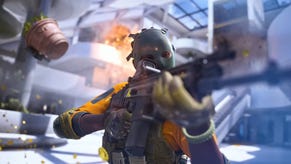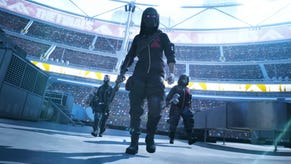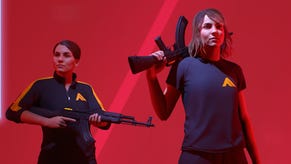The Finals review - mechanically thrilling, thematically wanting
Artificial inelegance?
When you kill someone in The Finals, they explode in a shower of coins, their body scattering across the ground like a tub of popcorn dropped by King Midas. As with much else about the Finals, this wowed me when I first saw it. What an ingenious way to depict death in a multiplayer shooter, I thought. It's spectacular without being grisly, satisfying without being gross. Don't get me wrong, I'm a sicko for virtual gore. But this seemed like a smart, clean alternative.
The longer I played the Finals, though, the more its glittering corpses troubled me. The Finals is explicitly a game about exchanging death for money, a free-to-play multiplayer shooter where you compete in teams for virtual cash prizes, and pay real money to give your tracksuit-wearing competitor a snazzier outfit. Its smash-n-grab gunfights are satisfying in the moment, with sleek movement, precision-engineered weapons, and an exhilarating destruction mechanic. Look closer, though, and you'll spot an emptiness behind its contestants' eyes, one that speaks volumes not just about The Finals, but of modern multiplayer shooters in general.
We'll get to all that in due course, but first, let's give The Finals the credit it deserves. The premise is intriguing and unusual - a multiplayer shooter that blends the cooperative heists of Payday with the explosive destruction of Bad Company 2. The Finals offers three game modes to choose from, but the one you'll probably play most, Quick Cash, sees three teams of three players competing to grab Vaults filled with coins, then transfer them to cashout points to gain the funds. The first team to successfully cash out twice wins.
But ah, a twist! The vault can be "stolen" by another team at any point, whether you're waiting for it to initially unlock, transferring to the cashpoint, or during the cash out process. The result is a rolling game of attack and defence, with the vault constantly changing hands in frantic three-way battles.
Further complexity is added by the composition of those teams. Before a match, you can select one of three "body types": light, medium and heavy. These are basically classes, with each having a different movement speed, health bar, weapon roster, and abilities. Light contestants are speedy glass cannons, with skills that revolve around stealth and athleticism, and small but punchy weapons like suppressed SMGs and sawed-off shotguns. Medium contestants play a supporting role, able to quickly heal and revive teammates, and deploy defensive structures like turrets. Heavy contestants are all about dealing and absorbing damage, wielding sledgehammers and big machine guns while putting down deployable cover.
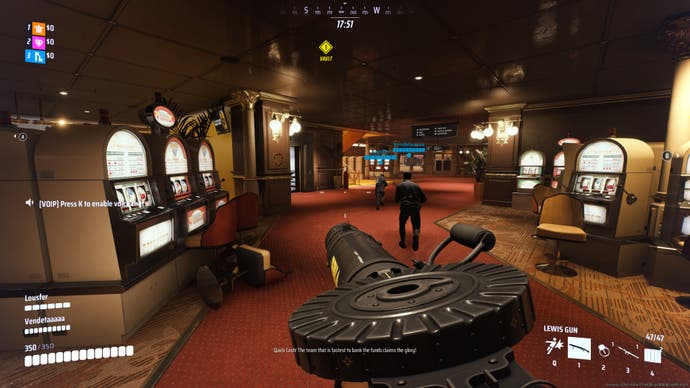
Even at this level, The Finals is an entertaining, tightly designed shooter. Movement is propulsive even when playing as the heavy, and navigating maps is fun in and of itself. Maps are littered with bounce-pads and ascension cables to speed you along to the action, while some classes get their own methods of enhancing traversal, like the Medium contestant's deployable bounce-pads, or the Light contestant's grappling hook. Combat deftly straddles the line between skill and tactics. While a sharp aim will certainly help you in the Finals, it isn't a case of fastest-finger always wins. Even the Light build can withstand a couple of seconds of sustained gunfire, giving you time to react to being ambushed and use your skills to level the playing field.
But the real magic in the Finals is provided by its destruction system, which lets you destroy the walls, floors, ceilings, and windows of pretty much any building that you're in. You can even level entire structures, trapping anyone inside in a twisted mess of rubble and debris. Blowing up the map is entertaining in its own right, but more importantly, it heightens the mixture of tactics and chaos inherent to a multiplayer shooter. If a team is defending a cashpoint on the upper floor of a building, for example, then you can blow up the walls to flank them, blow up the roof to attack from above, or blow out the floor underneath the cashpoint, sending it tumbling down to your level where you can attempt to steal it. More than once I've seen a team deliberately smash a building to pieces to conceal the cashpoint inside the rubble, making it harder for other teams to access.
On the flipside, the destruction system means the shape of a match can alter dramatically. For example, you might try to escape being attacked by smashing through a wall. But that then creates a new thoroughfare other players might use. Likewise, blowing out the walls surrounding a cashpoint might help you steal it, but it'll also make it harder to defend later. In one match I had, our three teams spent ages fighting over a vault at the outset of a match, slowly tearing the building apart as the vault gradually bounced down from the top floor to the ground.

At its best, The Finals is electric, and feels like a breath of fresh air in the multiplayer FPS. So why the three stars? Well, the game does have some logistical issues. Movement and teamwork are so essential to The Finals that the game quickly breaks down when these elements are impeded. Heavy contestants, for example, have a much harder time moving around maps. Not only are they markedly slower than other builds, they also have no traversal gadgets. They can use certain abilities to smash through walls, but that doesn't help much when they need to travel upward or cross large gaps. This is especially problematic on maps like Skyway Stadium, where there are a lot of instant-death pitfalls and areas where you can just get stuck.
The Quick Cash mode also has an inherent flaw, which is that your efforts to control the play-space only really matter during the cashing out phase of the round. Neither unlocking nor chasing the vault improves your chances of winning, so you could just hang around for ten minutes and ambush the Cash Point in the final few seconds to win the match. Interestingly, this isn't the case in the three-round "Tournament" variant of the mode (known as Cash Out), which does provide small bonuses for grabbing and moving the vault. These can be the difference between qualification and knockout, which is much better. However, playing Cash Out also requires you to commit to (up to) three full matches and has ticketed respawns, which makes it significantly more demanding.

Most of these problems are mitigated by The Finals' other mode, Bank It, which involves stealing coins off other players rather than from set points on the map. Although players are still divided into teams, working together is less crucial to success, so your differing movements speeds cause fewer problems. The downside is that Bank It is more of a straight up gunfight, with the destruction systems playing a less central role.
In short, while the Finals' game modes are fun, none of them make the most of the combat systems Embark Studios has designed. My bigger issue with The Finals, however, starts with its AI voiceovers. This is by far the most contentious feature of The Finals, to the point where it's actively put some people off playing it. Basically, the Finals has two unseen commentators that contextualise and respond to events occurring in the game. These roles have human actors behind their voices, though much of the dialogue you'll hear is AI-generated.
To clarify my own stance on AI, I'm sceptical about many aspects of it, from how LLMs have been developed using datasets that include copyrighted materials, to how the technology now poses yet another threat to the livelihoods of creatives. That said, I'm not against the notion of using the tech in games if it's to do something new and innovative. And at first, I thought that was what The Finals was doing. When a match starts, the game randomly assigns your team a name like "The Powerhouses" or "The Retros". Initially, I thought these names were being made up on the fly, and the AI voiceover was dynamically adjusting the commentary to fit. That would be a justifiable use case, as that isn't something a human can feasibly do.

But it wasn't long before the team names began repeating, and it became clear that The Finals' voiceover uses standard narrative design techniques, but with AI voices instead of human actors. Not only is this kinda crummy, it also makes the game worse. Quality-wise, the voiceovers aren't egregiously bad. You might hear an oddly intoned sentence or clipped phrase, but they do sound mostly like humans. Unfortunately, they also sound profoundly boring. Their personalities are basically "enthusiastic American" and "clean-cut British lady" but they go no deeper than that, and their commentary is neither insightful nor interesting. It's also a missed opportunity to put a real stamp of personality on the Finals. A great commentator can not only add enormous entertainment value, they can define that experience for the entire audience. Just look at what John Motson did for BBC football, or what Craig Charles added to Takeshi's Castle. For millions of people, their names are synonymous with those televisual experiences.
Having a reactive voiceover to a multiplayer shooter is a fantastic idea, but Embark Studios' execution of it sucks. The lines are dull, the AI voices cannot make them interesting, and you just end up mentally filtering out the noise. Crucially though, this isn't an isolated issue. In most areas of its presentation, The Finals lacks a distinctive identity. Your characters are all just regular joes wearing grey tracksuits. The game uses italicised impact for its font. The weapons are all standard pistols, shotguns, HMGs and so forth. The maps are clean and colourful, but there's nothing especially memorable about them. Even the allocated team names are bland. You'd hear more imaginative examples at your local pub quiz!
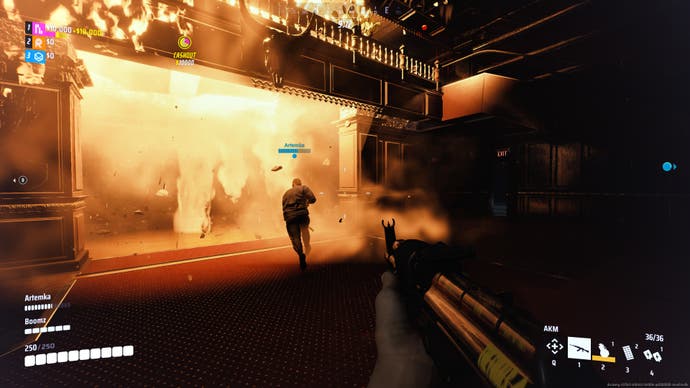
More broadly, the entire game show premise is inconsistently applied. It's supposed to be a virtual game show, a game within a game scenario. But then why is there a huge ring of spectators surrounding the map? Why are the maps themed around real-world locations like Monaco and Las Vegas? And given the game's emphasis on clean, modern visuals, why do you respawn through an eighties' arcade-style "Insert coin" menu? Perhaps it's because I grew up with nineties' British game shows like Funhouse and The Crystal Maze, where the presenters were weird, the prizes were rubbish, and the experience was what ultimately mattered, but as a game-show experience, I find The Finals' game-show theme to be deeply unimaginative.
Only the developers know why The Finals is so aesthetically anodyne. But if I were to speculate, I'd say it's so the game can more easily support the huge variety of weapon and character skins that bankroll every modern multiplayer FPS. Nearly all your major multiplayer shooters are Ready Player One now, an ugly morass of garish weapon skins and brand-based avatars with no consideration for thematic consistency or artistic integrity. In a game like Call of Duty, which is supposedly a serious military affair, this stuff stands out like Winnie the Pooh in the Somme. Better to keep your shooter's visual style as neutral as possible, then you can put anything in and it'll look alright.
This is why I feel queasy that The Finals' most distinctive visual flourish is a shower of coins. It's a stark reminder that the Finals' main concern, both thematically and semantically, is making money. And yes, most games are made with the hope of a financial payoff at the end. But I don't want to feel that desire from them while I'm playing. I want to be invested in your game's world, in its characters, in its tactics, in its meta, whatever you've got. I want it to be about more than the coins I can earn, the skins you can sell to me. For all the potential in its combat, I don't think the Finals has a whole lot to get invested in. The game modes are too uneven, and the theme feels like it's waiting for the brands to drop. The combat and destruction tech make it worth a few hours of your time. But no matter how much cash the Finals flashes, I've no desire to spend any of my own.
A copy of The Finals was independently sourced for review by Eurogamer.






